Reduced RG-II pectin dimerization disrupts differential growth by attenuating hormonal regulation
- PMID: 39937898
- PMCID: PMC11817947
- DOI: 10.1126/sciadv.ads0760
Reduced RG-II pectin dimerization disrupts differential growth by attenuating hormonal regulation
Abstract
Defects in cell wall integrity (CWI) profoundly affect plant growth, although, underlying mechanisms are not well understood. We show that in Arabidopsis mur1 mutant, CWI defects from compromising dimerization of RG-II pectin, a key component of cell wall, attenuate the expression of auxin response factors ARF7-ARF19. As a result, polar auxin transport components are misexpressed, disrupting auxin response asymmetry, leading to defective apical hook development. Accordingly, mur1 hook defects are suppressed by enhancing ARF7 expression. In addition, expression of brassinosteroid biosynthesis genes is down-regulated in mur1 mutant, and supplementing brassinosteroid or enhancing brassinosteroid signaling suppresses mur1 hook defects. Intriguingly, brassinosteroid enhances RG-II dimerization, showing hormonal feedback to the cell wall. Our results thus reveal a previously unrecognized link between cell wall defects from reduced RG-II dimerization and growth regulation mediated via modulation of auxin-brassinosteroid pathways in early seedling development.
Figures





References
-
- S. C. Fry, Cell walls, in Encyclopedia of Applied Plant Sciences (Academic Press, ed. 2, vol. 1, 2017), pp. 161–173.
-
- Jonsson K., Hamant O., Bhalerao R. P., Plant cell walls as mechanical signaling hubs for morphogenesis. Curr. Biol. 32, R334–R340 (2022). - PubMed
-
- Schoenaers S., Lee H. K., Gonneau M., Faucher E., Levasseur T., Akary E., Claeijs N., Moussu S., Broyart C., Balcerowicz D., AbdElgawad H., Bassi A., Damineli D. S. C., Costa A., Feijó J. A., Moreau C., Bonnin E., Cathala B., Santiago J., Höfte H., Vissenberg K., Rapid alkalinization factor 22 has a structural and signalling role in root hair cell wall assembly. Nat. Plants 10, 494–511 (2024). - PMC - PubMed
-
- Moussu S., Lee H. K., Haas K. T., Broyart C., Rathgeb U., Bellis D. D., Levasseur T., Schoenaers S., Fernandez G. S., Grossniklaus U., Bonnin E., Hosy E., Vissenberg K., Geldner N., Cathala B., Höfte H., Santiago J., Plant cell wall patterning and expansion mediated by protein-peptide-polysaccharide interaction. Science 382, 719–725 (2023). - PubMed
MeSH terms
Substances
LinkOut - more resources
Full Text Sources
Research Materials

